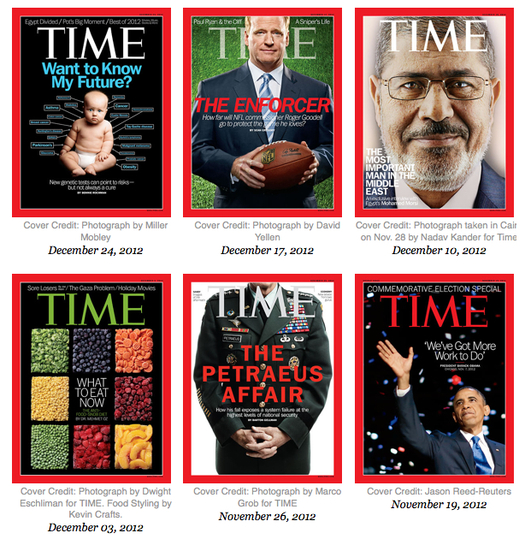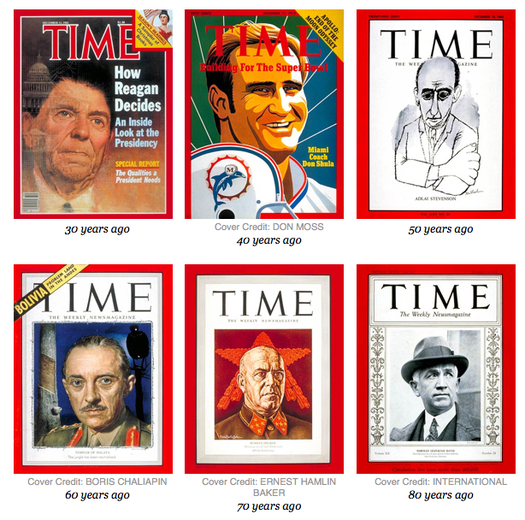The hoo-ha about Instagram, roughly coinciding with Time naming its "person of the year," has reminded me of an event I was puzzling over a couple of months ago: For its Hurricane Sandy cover, Time Magazine selected an image taken via the image-based social network. That sounds like a landmark moment.
But what I was puzzling over was what “the cover of Time Magazine,” as an idea, really means at this point. Once upon a time, of course, it was a declaration: An authoritative statement from the experts about What (or Whom) To Talk About. But how often do you actually see the cover of Time these days, anyway? And what does the magazine’s cover choice communicate to you on any given week? Here from Time’s site are six recent covers:

Recent Time covers, via Time.com
I think I remember noticing that Petraeus cover, but not the others. In general I'd say these covers are either trying to get in on what you were already talking about anyway, or attempts to "go viral," not so much declarations as auditions. Actually the 2012 Time cover I’m most familiar with was the one showing a young mom apparently breast-feeding her three-year-old. That actually did go viral, but from what I can recall the chatter was about the image, rather than the article (something about “attachment parenting,” which sounded like the sort of lifestyle/trend story that I am totally incapable of paying attention to). In other words, the cover was the story, at least in terms of what people reacted to online.
Still, despite all the obvious points that could be made about the struggle for weekly magazine relevance in the nonstop news cycle, I think the idea of the cover of Time remains meaningful — a handy metaphor or bit of shorthand, almost like the informationflow equivalent of a skeumorph.
Maybe that last comparison is a stretch. But it’s clearly easier to complain that some skeumorphs seem dated than in it is to suggest replacement metaphors with the same instant effectiveness. And there’s something similar here: Sure, the days of a Time cover seeming like an importance annointment are pretty much over. But, really, what’s taken its place? Trending topics on Twitter? Buzzfeed’s “Hot On The Web” list?
Okay, so it’s not like Time’s Hurricane Sandy cover suddenly put Instagram on the map, or even affirmed its pervasiveness — the service was clearly already mass, Time itself already had an Instagram account, etc. But on the other hand, people took note specifically because this was a clearly legible marker of something, even it’s something we all pretty much knew.

Older Time covers, via Time.com
Arriving at some kind of replacement for that would involve a consensus not just about what has authority this second, but about what has authority that could plausibly endure. Which brings me back, actually, to the current Instagram hoo-ha. The Sandy picture that Time put on its cover was taken by Benjamin Lowy, who is not a random cameraphone hobbyist, but a pro who happened to use Instagram. Turns out he’s among those who reacted to Instagram’s new terms of service by announcing that — for the moment, at least — he’ll be posting his images elsewhere.


Comments [6]
Which says a lot about how the media is a lot faster, but a lot more repulsive and reactionary and still parasitic to traditional news sources.
12.22.12
03:17
I'd add the Google home-page doodles to this list of parallels to Time's "person of the year" cover. Maybe in the age of the overwhelming and dispersed present tense, only that bit of the past that is celebrated widely can be thought to represent a collective viewpoint.
12.24.12
11:27
Rob,
Hoo-ha in London, is a commotion. In San Francisco, Hoo-ha means something entirely different.
Class action lawsuit against Instagram for TOS changes
With a little luck + an ethical TOS 'The Cover of Time' may mean something in the future. If your photo’s Exif has been erased without your knowledge, by a free app that distorts your photos to make them look older and lower quality . . . kind of like a Polaroid, then perhaps you may want to consider reading this class action lawsuit.
For my friends benefit, I would like to see certain social network applications incorporate the Creative Commons into their interfaces. The Creative Commons may be the best way to persuade others to value artwork properly. The Creative Commons may also be a way for Social network companies regain the public trust by doing the right thing.
Exif = Exchangeable image file format
12.25.12
12:05
http://www.architizer.com/en_us/blog/dyn/5689/time-cover-nostalgia/#.UNyI-xiyUZw
No biographical article on an architect is complete without an illustration of the cover, and I know I've used the Saarinen cover in a number of lectures as a sort of shorthand for mass cultural familiarity. Now there is "the New Yorker profile," that covers a slimmer wedge of mass culture. But in some ways it seems like licensing has replaced journalism as a mark of fame outside the profession.
12.27.12
12:47
Alexandra: I love that point about licensing deal as significance shorthand: When you've got a line of [whatever] at Target, you've really made it. Works for celebrities, sports figures, artists, etc., too...
12.28.12
09:29
http://www.flickr.com/creativecommons/
01.04.13
11:55